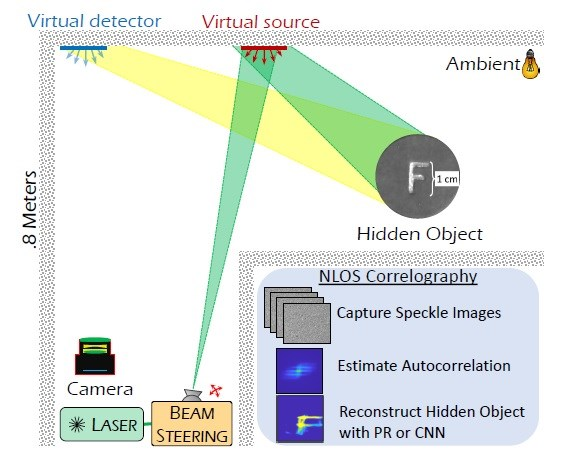Jan 17 2020
Scientists have successfully developed a novel laser-based system by harnessing the power of a new kind of artificial intelligence called deep learning. The new laser-based system can allow real-time imaging of hidden objects around corners.
 The non-line-of-sight imaging system uses a deep-learning algorithm to reconstruct hidden objects from a speckle pattern created by the laser. Image Credit: Prasanna Rangarajan, Southern Method University.
The non-line-of-sight imaging system uses a deep-learning algorithm to reconstruct hidden objects from a speckle pattern created by the laser. Image Credit: Prasanna Rangarajan, Southern Method University.
Additional development of the laser-based system may one day allow self-driving cars to “look” around busy intersections or parked cars to see pedestrians or any sign of dangers. The system may also be installed on spacecraft and satellites to perform tasks like capturing images within a cave existing on an asteroid.
Compared to other approaches, our non-line-of-sight imaging system provides uniquely high resolutions and imaging speeds. These attributes enable applications that wouldn't otherwise be possible, such as reading the license plate of a hidden car as it is driving or reading a badge worn by someone walking on the other side of a corner.
Christopher A. Metzler, research team leader, Stanford University and Rice University
Metzler and collaborators from Rice University, Southern Methodist University, and Princeton University have published their study results in Optica, the high-impact research journal from The Optical Society, describing that the novel laser-based system can differentiate sub-millimeter details of a concealed object from a distance of 1 m.
While the laser-based system has been developed to image tiny objects at extremely high resolutions, it can also be integrated with other kinds of imaging systems that create room-sized reconstructions at a low resolution.
Non-line-of-sight imaging has important applications in medical imaging, navigation, robotics, and defense. Our work takes a step toward enabling its use in a variety of such applications.
Felix Heide, Study Co-Author, Princeton University
Solving an Optics Problem with Deep Learning
The latest laser-based imaging system employs a camera sensor that is available on the market and also a robust yet otherwise typical laser source just like the one present in a laser pointer.
The laser beam reflects off a perceptible wall onto the concealed object and then bounces back onto the visible wall. This phenomenon produces an interference pattern called a speckle pattern that encodes the concealed object’s shape.
A complex computational problem had to be solved to rebuild the concealed object from the speckle pattern. While short exposure times are required for imaging in real time, they create so much noise that present algorithms cannot work. Hence, to overcome this issue, the investigators eventually turned to deep learning.
Compared to other approaches for non-line-of-sight imaging, our deep learning algorithm is far more robust to noise and thus can operate with much shorter exposure times. By accurately characterizing the noise, we were able to synthesize data to train the algorithm to solve the reconstruction problem using deep learning without having to capture costly experimental training data.
Prasanna Rangarajan, Study Co-Author, Southern Methodist University
Seeing Around Corners
To test the latest method, the scientists reconstructed the images of numbers and letters that measured 1 cm in height and concealed behind a corner. They achieved this by utilizing an imaging setup that measures approximately 1 m from the wall. The method used an exposure time of a quarter of a second to produce reconstructions with a 300-µm resolution.
The study is part of DARPA’s Revolutionary Enhancement of Visibility by Exploiting Active Light-fields (REVEAL) program. The program is developing a wide range of methods to image concealed objects around corners.
Currently, the scientists are working to make the laser-based system viable for additional applications by extending the field of view to enable the system to rebuild larger objects.